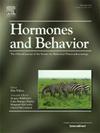在合作繁殖的慈鲷中,优势性和攻击性与后叶催产素神经元数量有关。
IF 2.4
3区 医学
Q2 BEHAVIORAL SCIENCES
引用次数: 0
摘要
在统治等级中,个体必须以与等级相适应的方式互动,因此行为及其潜在的神经机制必须随着社会地位而改变。其中一种潜在的神经机制是精氨酸催产素(AVT),这是一种非肽,涉及脊椎动物类群的优势和攻击调节。我们研究了水仙花水仙(Neolamprologus pulcher)的社会地位、优势相关行为和催产素神经元数量之间的关系。水仙花慈鲷生活在稳定的、混合性别的、合作繁殖的社会群体中,这些群体被组织成线性的统治等级。群体中的男女成员都表现出复杂的行为表现,这取决于他们当前的社会地位。我们记录了水仙花慈鲷群体中的激动行为,并将这些行为与大脑视前区三个不同神经元群体中的AVT细胞数量联系起来,比较了社会地位和性别的差异。我们发现,在优势个体中,旁细胞AVT神经元比从属个体更丰富。我们还发现,在优势个体中,小细胞和大细胞AVT神经元的数量与攻击性呈正相关。幼鱼的AVT神经元计数与服从行为无关。我们的数据强调AVT在调节社会脊椎动物的地位和攻击中的作用。本文章由计算机程序翻译,如有差异,请以英文原文为准。
Dominance and aggressiveness are associated with vasotocin neuron numbers in a cooperatively breeding cichlid fish
Within dominance hierarchies, individuals must interact in a rank-appropriate manner, thus behavior and its underlying neural mechanisms must change with social status. One such potential neural mechanism is arginine vasotocin (AVT), a nonapeptide which has been implicated in the regulation of dominance and aggression across vertebrate taxa. We investigated the relationship between social status, dominance-related behaviors, and vasotocin neuron counts in daffodil cichlids (Neolamprologus pulcher). Daffodil cichlids live in stable, mixed-sex, cooperatively breeding social groups that are organised into linear dominance hierarchies. Group members of both sexes exhibit complex behavioral repertoires which differ depending on their current social status. We recorded agonistic behaviors within groups of daffodil cichlids and correlated these with the number of AVT cells within the three distinct neuronal populations in the preoptic area of the brain, comparing across social status and sex. We found that parvocellular AVT neurons were more abundant in dominant individuals than subordinates. We also found that numbers of both parvocellular and magnocellular AVT neurons were positively associated with aggression in dominant individuals. AVT neuron counts were unrelated to submissive behavior in subordinate fish. Our data emphasise the role of AVT in modulating status and aggression in social vertebrates.
求助全文
通过发布文献求助,成功后即可免费获取论文全文。
去求助
来源期刊

Hormones and Behavior
医学-行为科学
CiteScore
6.70
自引率
8.60%
发文量
139
审稿时长
91 days
期刊介绍:
Hormones and Behavior publishes original research articles, reviews and special issues concerning hormone-brain-behavior relationships, broadly defined. The journal''s scope ranges from laboratory and field studies concerning neuroendocrine as well as endocrine mechanisms controlling the development or adult expression of behavior to studies concerning the environmental control and evolutionary significance of hormone-behavior relationships. The journal welcomes studies conducted on species ranging from invertebrates to mammals, including humans.
 求助内容:
求助内容: 应助结果提醒方式:
应助结果提醒方式:


